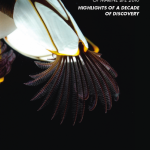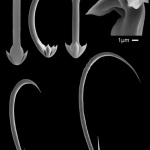Over ten years ago Fred Grassle, a marine biologist with deep-sea tendencies, and Jesse Ausubel, program director for Alfred P. Sloan Foundation, started conversing on an initiative to document the biodiversity of the oceans. That program, the Census of Marine Life, started in 2000 with the goal “to advance a major new international observational program to be completed by 2010 to assess and explain the diversity, distribution, and abundance of marine life.” That program lead to the support of several field projects and expeditions (currently over 15), the Ocean Biogeographic Information System (OBIS), several initiatives focused on specific environments (abyssal plains, vents, seeps, seamounts, corals, continental margins, etc.), conferences, taxonomic workshops, and much more. Publications from CoML just from 2005-2008 number over 500. In 2010, a plethora of papers (species descriptions, synthesis papers, reviews, primary research) will hit journals including PLoS One Marine and Aquatic Sciences.
The project is completed by 2010, a little less than a month away. In the last ten years, The Sloan Foundation funded well over 100 million dollars for the CoML project. With a cadre of biologist, a huge budget, 14 field projects, and 210 expeditions, 17,650 new species were found and described. “The abyssal fauna is so rich in species diversity and so poorly described that collecting a known species is an anomaly,” says Dr. Billett. “Describing for the first time all the different species in any coffee cup-sized sample of deep-sea sediment is a daunting challenge.”
Five of the Census’ 14 field projects focus on the habitats below 200m – the continental margins (COMARGE: Continental Margins Ecosystems), the mid-Atlantic Ridge (MAR-ECO: Mid-Atlantic Ridge Ecosystem Project), the submerged mountains (CenSeam: Global Census of Marine Life on Seamounts), the muddy abyssal plains (CeDAMar: Census of Diversity of Abyssal Marine Life), and and chemically-driven ecosystems (ChEss:Biogeography of Deep-Water Chemosynthetic Systems). I’m involved with and received funding (yeah!) both under CenSeam and CeDAMar. As part of CeDAMar, I worked with a group developing a synthesis of abyssal diversity.
“There is both a great lack of information about the ‘abyss’ and substantial misinformation,” says Dr. Carney. “Many species live there. However, the abyss has long been viewed as a desert. Worse, it was viewed as a wasteland where few to no environmental impacts could be of any concern. ‘Mine it, drill it, dispose into it, or fish it – what could possibly be impacted? And, if there is an impact, the abyss is vast and best yet, hidden from sight.’ “Census of Marine Life deep realm scientists see and are concerned.






2 Replies to “Cataloging Life On the Deep-Sea Floor”
Comments are closed.